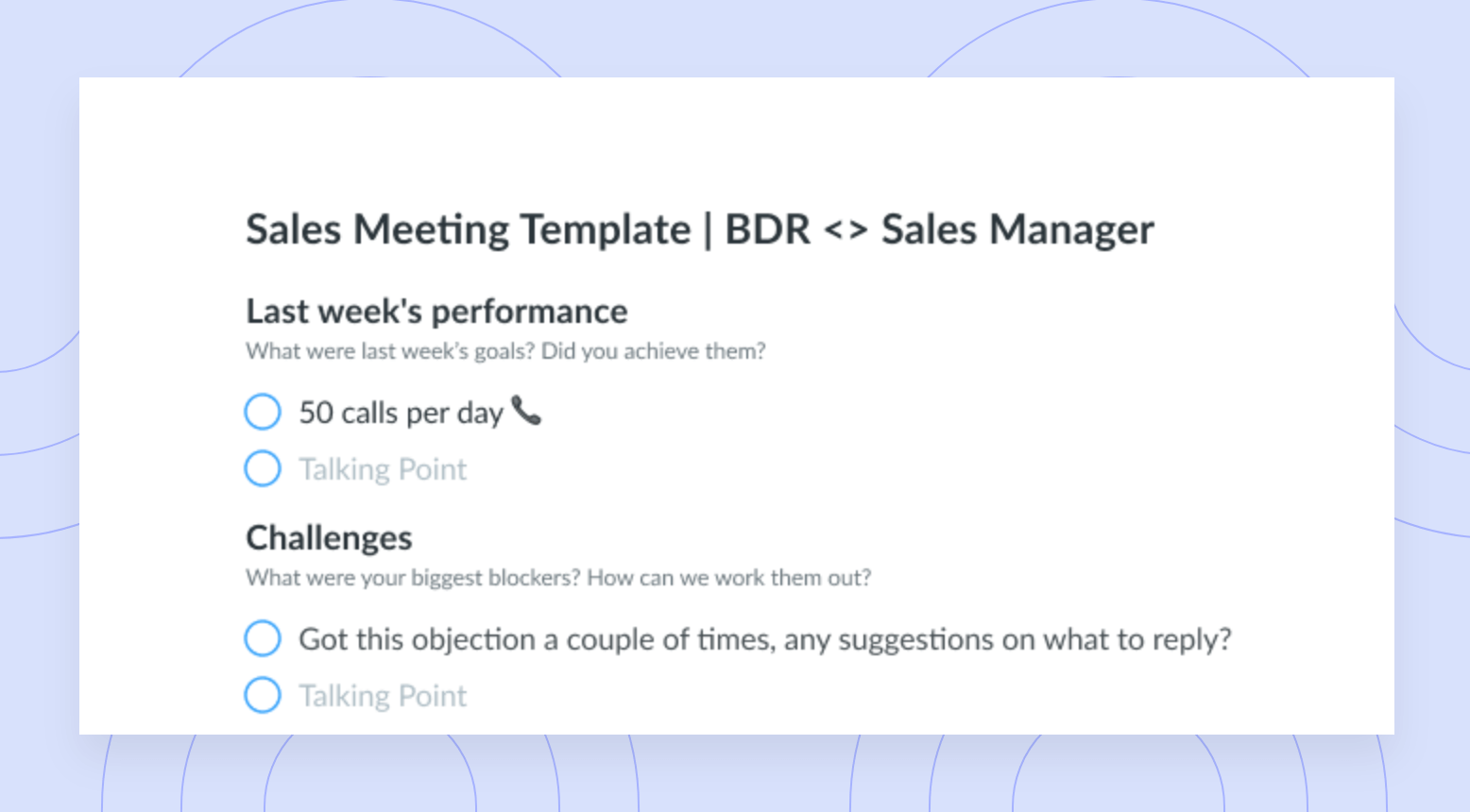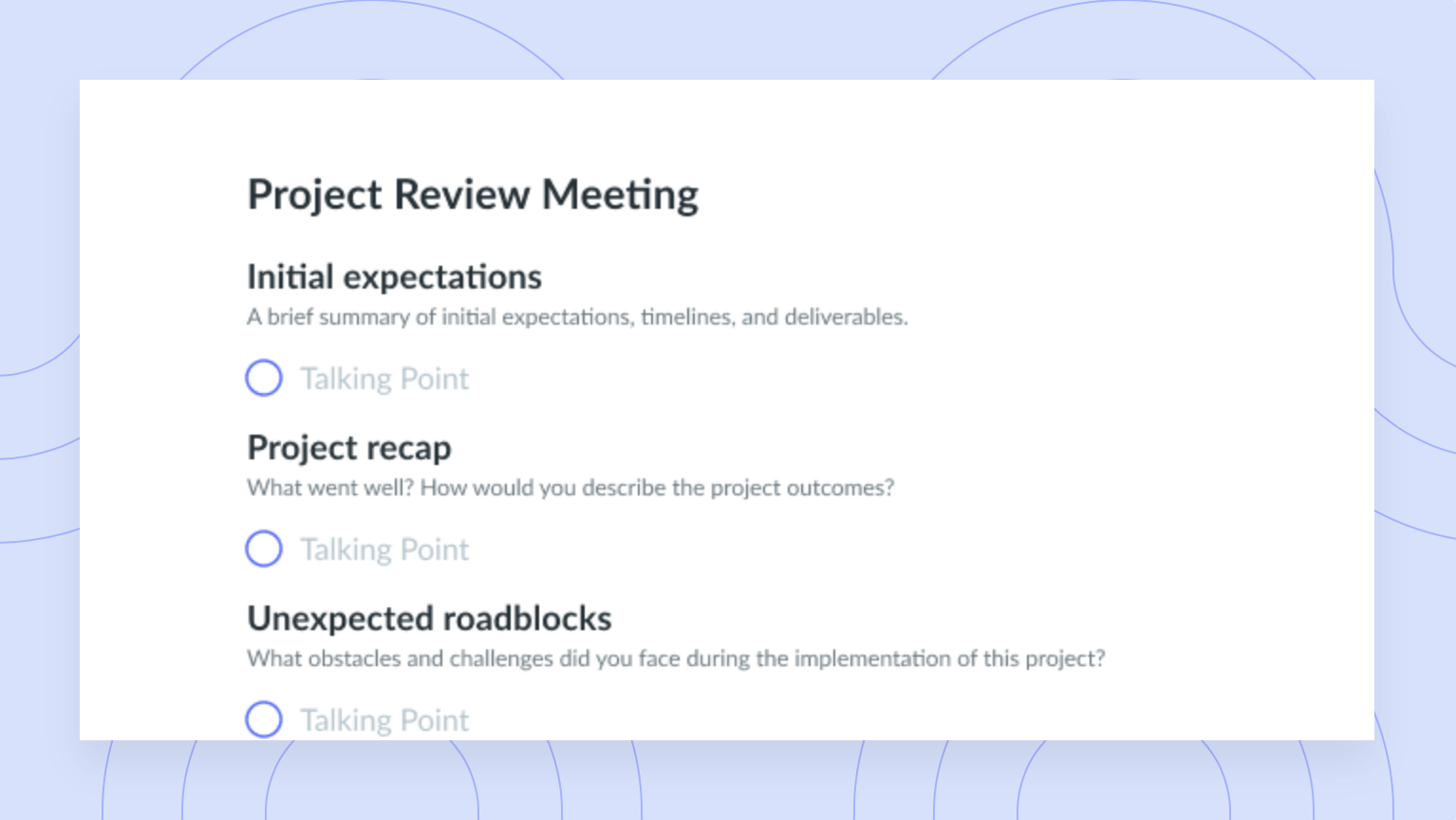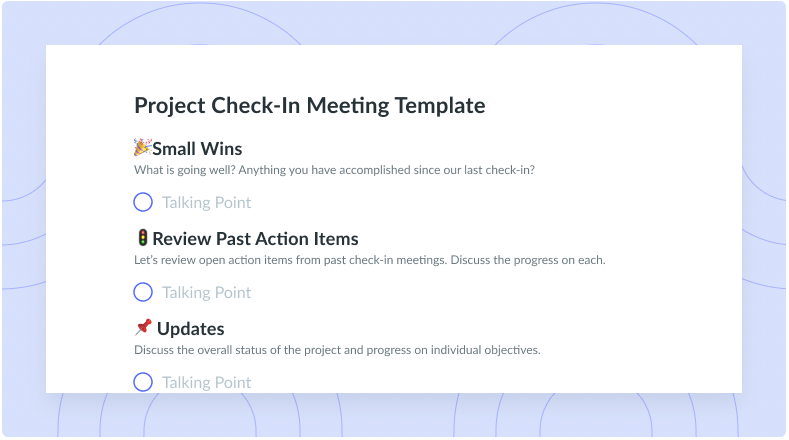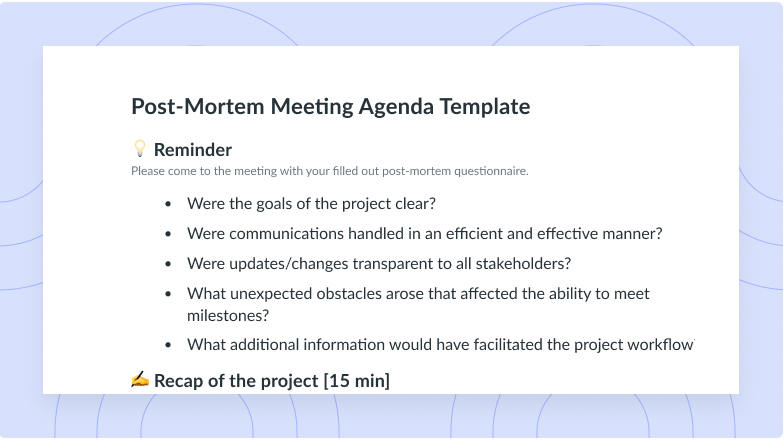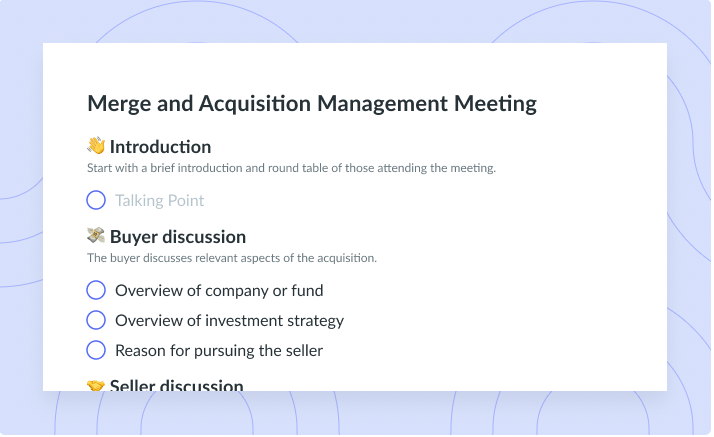Creative Project Management: Everything You Need to Know
Reach new innovative heights by implementing creative project management skills into your day-to-day work!
Have you ever looked at one of your company’s beautifully designed final products with amazement and thought to yourself “how on earth did the creative team make it look THIS great?” Or perhaps you are an artist, copywriter, or designer and often wish you could implement your usual creative processes into new problem-solving methods. Whether you’re naturally imaginative or are simply looking for new ways to feel inspired at work, implementing creative project management skills could be your one-way ticket to new levels of productivity.
Let’s take a look at creative project management, why it’s important, and five steps you can take to become an effective creative project manager in your own role.
- What is creative project management?
- What does a creative project manager do?
- Why creative project management is important
- Creative project management terms
- Creative versus traditional project management
- How to become an effective creative project manager
- Project management free meeting agenda template
What is creative project management?
Creative project management refers to project management within creative industries. Think brand marketing, graphic design, video production, photography, copywriting, advertising, and numerous other skill sets and processes that form our creative economy.
It’s stereotypical to assume that creatives are disorganized, frazzled, or poor communicators at work. It’s hard to imagine that an individual who is naturally skilled at “right-brained” traits like imagination and intuition can also be logical, fact-driven, or process-oriented. In reality, employees within creative industries are often quite talented at balancing their artistic pursuits with demanding business requirements.

Level up your productivity
Keep track of all your creative ideas, action items, and meetings in one collaborative tool. Try a tool like Fellow!

What does a creative project manager do?
A creative project manager oversees employees from a wide range of creative backgrounds. An individual in this type of management role could be overseeing a team of content creators or reviewing the work of graphic designers one day, and signing off on large-scale advertisements and video productions later that week. These professionals need to be able to take into account the quirks that come with working with creatives, while remaining committed to processes and plans.
Creative project managers need to possess a wide range of skills. First, they should be excellent planners and organizers so they can lead clients, stakeholders, and employees through the creative project planning process. They also have to be capable of organizing budgets and ensuring their teams have the resources needed to execute both small- and large-scale projects. Additionally, creative project managers need to be stellar communicators. They should be able to act as a liaison between their team and clients or other departments within the organization.
Creative project managers are usually the ones who share regular updates and information, and relay feedback to all parties involved in an assignment. Some other traits that creative project managers should possess include: empathy, problem-solving skills, open-mindedness, and of course, creativity!
Why creative project management is important
Let’s face it: we could all use someone to give us a nudge when we’re being a bit too idealistic. It’s always important to have a teammate who can empower others to create amazing work and reach milestones. That’s where creative project managers come in! This type of project management is key to the success of teams within the creative industries because it helps provide context and sequence to out-of-the-ordinary tasks. Creative project managers do a great job at appreciating their team members’ eccentricities while helping them manage their demanding workloads. Leaving this type of role out of your organization could lead to communication barriers between creatives and more process-oriented departments within your organization.

Creative project management terms
- Creative assets: These are any visual files that help a brand tell their story. Creative assets like photographs, videos, brand guidelines, audio files (for example, podcasts or brand-specific jingles), graphics, and even spreadsheets can be used as a part of marketing campaigns, social media outreach, blog content, and much more.
- Creative workflow: This is the set process your team will follow to complete a series of creative tasks. If you have an effective creative workflow, your team should be able to move through any assigned project with confidence. The set of tasks within a creative process may include brainstorming and delegating smaller pieces of the client request to members of the creative team, establishing a project timeline, scheduling regular check-ins for teammates, and sending the final project for review upon completion.
- Creative resource management: As a creative project manager, your two biggest creative resources to manage will be your team and their time. Thankfully, this management is as simple as knowing and leveraging your colleagues’ strengths and following up on assigned tasks with clear expectations and reasonable deadlines.
Creative versus traditional project management
The difference between creative and traditional project management is in the planning and execution. While a traditional project manager will have a set timeline and guidelines for each task, creative project managers usually take a less traditional approach to managing larger projects.
This isn’t to say that creative project managers aren’t organized. Creativity is simply more subjective, making success more subjective as well. For example, a traditional project manager may push employees to optimize their productivity to reach a specific goal, whereas a creative project manager may prioritize fostering creativity and the talent of employees alongside completing their objectives. A traditional product manager may motivate their team to complete their tasks as fast as possible, while a creative project manager may encourage their teammates to simply produce the most innovative product possible, so long as the timeline is within reason and budget. Both traditional project managers and creative project managers care about the success of their teams above all else!
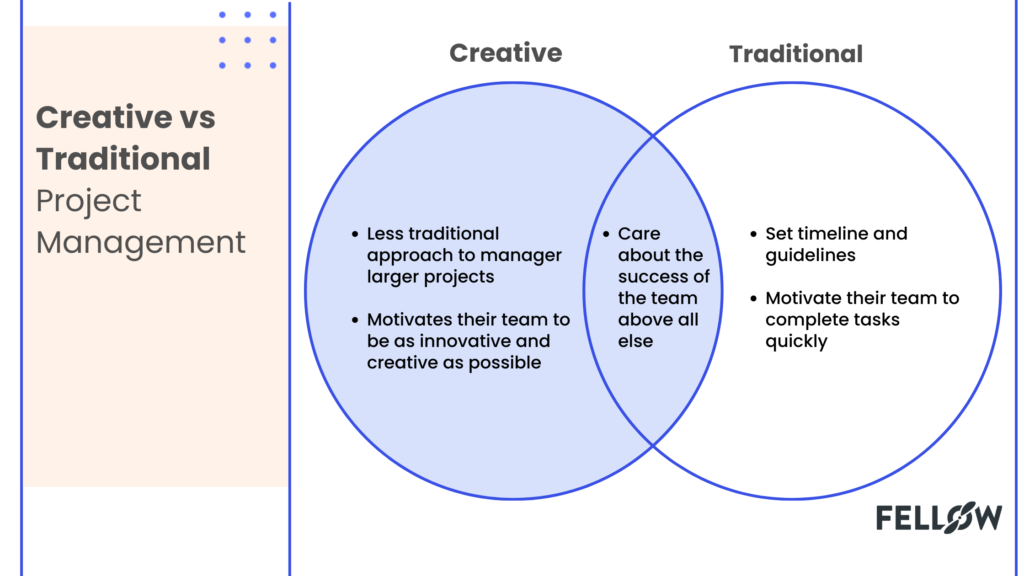
How to become an effective creative project manager
- Define project scope
- Set clear goals and objectives
- Be transparent
- Provide recognition
- Hold regular one-on-ones
- Get creative
1Define project scope
Project scope is a detailed outline or overview of all aspects of a project including, but not limited to, resources needed, timelines, deliverables, and project boundaries. A solid project scope will also outline processes, assumptions, constraints, and an in-depth project overview that informs key stakeholders of said components.
2 Set clear goals and objectives
Creative teams require processes for planning and executing tasks in the same way that technical teams do. If you’re beginning a new role as a creative project manager, gather your team to discuss short- and long-term goals. Discuss important topics like key performance indicators (KPIs), workloads, and operations as well. Take the time to answer questions and establish processes for delegating work, conducting reviews, giving feedback, and managing workflows. Use Fellow to track your objectives as part of your meeting workflow and stay on top of your team’s goals!
3 Be transparent
You’re not a videographer, and your videographer isn’t a project manager. There’s no need to pretend like you understand the nuances of each skill set within your creative team. Be transparent about your knowledge gaps and maintain open communication with each teammate. Creative projects may take longer to complete than other tasks and involve more people. The more you learn what your employees need from you, the better you’ll understand how to make their jobs easier!
Trust and transparency plays an important role, because you build trust with transparency. You need to be transparent and contextual in the right way with your team, but you always have to default to transparency…The key is a journey, the more you behave in a less reactive way, the more you’re going toward that direction of human centric leadership.
– Tony Jamous, CEO and Founder of Oyster HR
4 Provide recognition
Everyone loves a bit of positive feedback! Individuals thrive on recognition and praise, and creatives are no different. Use specific details when choosing to compliment a teammate’s work. Your copywriter colleague likely knows that they’re skilled at what they do, but would probably still love to hear that you thought the language they proposed for a client’s recent ad campaign was extremely clever. No matter how busy you become managing the details of your team’s projects, providing regular recognition will allow you to build rapport with your colleagues and celebrate wins together!
5 Hold regular one-on-ones
Host regular one-on-one meetings with each member of the creative team. During each session, you should give and receive feedback, see what the employee needs from you to better do their job, assign action items, clarify expectations, and set realistic goals for any upcoming projects. These meetings should also be a time to build and establish trust with your team!
It’s really important to get to know your reports on a personal level, learn about them and whatever comfort level they have with sharing their personal lives. And then also giving feedback because I think showing that you’re invested in someone’s growth by giving them helpful, well worded feedback is a really good way to show that you have their best interests at heart and you care about them.
– Alexandra Sunderland, Senior Engineering Manager at Fellow.app
6 Get creative
It’s a creative team, so your approach to goal setting should also be… creative! Think outside the box. Work with your team to set goals that excite everyone. With a group of inventive and imaginative employees, you’re bound to come up with new ideas when you put your heads together. For example, you can map out monthly goals during a team meeting at the beginning of each quarter, and have one person design a vision board that can live in your office’s common area to remind the group of what they’re striving to achieve. Without creativity, there is no progress. Your team’s wildest suggestions could translate into some of their best results.
Project management free meeting agenda template

Creativity and structure breeds opportunity
Managing projects for creative teams can be incredibly rewarding when you have the proper people, processes, and tools in place. Whether you’re a creative project manager, work in the creative industries, or are simply looking for tips that can help you succeed in your own line of work, look no further than creative project management. Every team can benefit from a combination of creativity and structure. So, indulge your imagination, begin the planning process, and watch as your once-creative ideas translate into real-world results.












